Music-Crash-Course-TIME-and-Time-Signature
Intro
Written music specifies to the musician(s):
Which pitches to perform (indicated by notes), and when not to perform (indicated by rests)
When to perform notes and rests, indicated by horizontal placement on the stave and
How long to sustain each note or rest.
TIME (When to perform the notes and rests) notation is horizontal (left to right).
PITCH (Which notes to perform) notation is vertical (up and down).
How long to sustain each note or rest (Length) is indicated within the individual symbols.
Here is a slightly different drawing of the music graph. In this case, there is a "pitch line" and a "time line".
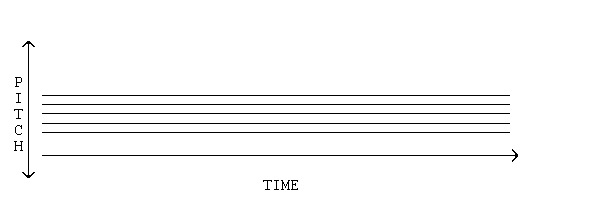 |
Contents
TIME
TIME in music (musical time) is measured much like conventional time.
With conventional time we use periods like the week, day, hour, minute and second.
However, unlike conventional time, musical time is based on even divisions -
that is, each division of time is 1/2 of another division of musical time.
(In conventional time, a day is 1/7 of a week, not 1/2 of a week; an hour is 1/24 of a day, not 1/2 of a day etc.)
The relationship between musical time and conventional time is called tempo.
Tempo describes the speed of the music, often express as:
How many units of musical time occur within a specified amount of conventional time.
TIME in music (or just TIME) uses symbols representing whole units (whole notes and whole rests),
and divisions of whole units (half notes, half rests, quarter notes, quarter rests, eight notes and so on).
Where these notes and rests are placed on the stave horizontally, indicates when the note and rests are to be performed.
Below is a stave with a "time line" showing equal and even divisions of whole units of time, represented here by integers (1.2.3.4.5...).
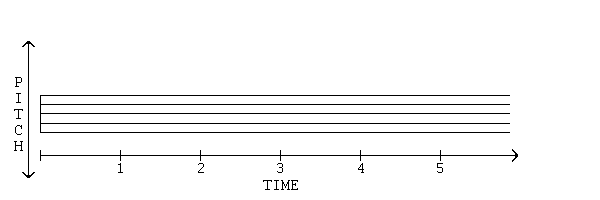
Whole units of time may occur at the rate of just a few per minute (seldom much less than 20) to several per minute (not often more than 60). However, music is rarely read in whole units, but rather in smaller divisions of whole units.
When whole units are divided, it is into equal and even divisions. 1/2 , 1/4, 1/8, 1/16 etc.
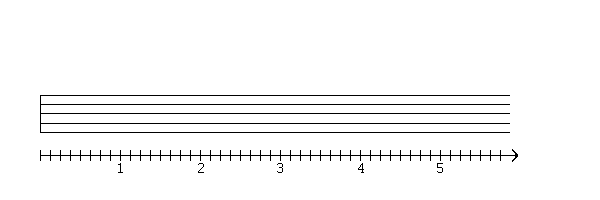
Below is a "time line" showing whole units and divisions of eight (8) equal and even parts.
Musical notation uses measures to assist the reader. The term 'measure' is appropriate, because it measures a specific amount of (musical) TIME. Measures are separated by measure lines. Measures are also referred to as bars, and measure lines are are also referred to as bar lines. Below are a few measures, each of which will "contain" one whole unit of TIME when appropriate symbols are placed upon it.

Not all measures contain whole units of TIME. For example, below are a few measures, each of which will contain 3/4 of one whole unit of TIME when appropriate symbols are placed upon it.

Time Signatures
The "time line" does not appear in musical notation. Instead, a time signature is used to define measures.
Time signatures are expressed as fractions. The basic form of a time signature is:
The top number (X) of the time signature will most often be:
2,3,4,6,9 or 12 - However 1,5,7 and 11 are also used.
Not so common will be numbers higher than 12.
___________________________________________
The bottom number (Y) of the time signature (beat) will, with rare exception, be:
2 (one half of one whole unit of time)
or
4 (one quarter of one whole unit of time)
or
8 (one eighth of one whole unit of time)
Time signatures are not necessarily expressed using the "lowest common denominator", a common practice in mathematics.
Which bottom number (2, 4 or 8) is used to represent the beat, significantly effects the notation of the music.
For example: Although 6/8=3/4 is a true mathematical equation, there is a quite a difference between music written using the time signature 3/4 and music written using the time signature 6/8. Other examples of time signatures that are mathematical equivalents but are not used interchangeably: 2/4 and 1/2; 4/4 and 2/2; 12/8 and 6/4 and 3/2.
A time signature is said to be "established" when it is placed at the beginning of a measure.
When a time signature is established, the following measures are of the same time signature, until another time signature is established.
Below is a stave with five measures of 4/4 TIME. The time signature is established in the first measure.
In 4/4 TIME, each measure will contain one whole unit of TIME (when note and rest symbols are placed on it.)
This is not necessarily the case with other time signatures; not all measures contain one whole unit of time in other time signatures.
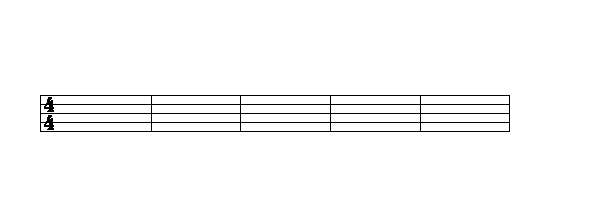
TIME in music (musical time) is measured much like conventional time.
With conventional time we use periods like the week, day, hour, minute and second.
However, unlike conventional time, musical time is based on even divisions -
that is, each division of time is 1/2 of another division of musical time.
(In conventional time, a day is 1/7 of a week, not 1/2 of a week; an hour is 1/24 of a day, not 1/2 of a day etc.)
The relationship between musical time and conventional time is called tempo.
Tempo describes the speed of the music, often express as:
How many units of musical time occur within a specified amount of conventional time.
TIME in music (or just TIME) uses symbols representing whole units (whole notes and whole rests),
and divisions of whole units (half notes, half rests, quarter notes, quarter rests, eight notes and so on).
Where these notes and rests are placed on the stave horizontally, indicates when the note and rests are to be performed.
Below is a stave with a "time line" showing equal and even divisions of whole units of time, represented here by integers (1.2.3.4.5...).

Whole units of time may occur at the rate of just a few per minute (seldom much less than 20) to several per minute (not often more than 60). However, music is rarely read in whole units, but rather in smaller divisions of whole units.
When whole units are divided, it is into equal and even divisions. 1/2 , 1/4, 1/8, 1/16 etc.

Below is a "time line" showing whole units and divisions of eight (8) equal and even parts.
Musical notation uses measures to assist the reader. The term 'measure' is appropriate, because it measures a specific amount of (musical) TIME. Measures are separated by measure lines. Measures are also referred to as bars, and measure lines are are also referred to as bar lines. Below are a few measures, each of which will "contain" one whole unit of TIME when appropriate symbols are placed upon it.

Not all measures contain whole units of TIME. For example, below are a few measures, each of which will contain 3/4 of one whole unit of TIME when appropriate symbols are placed upon it.

Time Signatures
The "time line" does not appear in musical notation. Instead, a time signature is used to define measures.
Time signatures are expressed as fractions. The basic form of a time signature is:
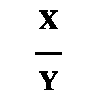 X= How many 'beats' define the length of the measure _________________________ Y= Which note is a 'beat' |
The top number (X) of the time signature will most often be:
2,3,4,6,9 or 12 - However 1,5,7 and 11 are also used.
Not so common will be numbers higher than 12.
___________________________________________
The bottom number (Y) of the time signature (beat) will, with rare exception, be:
2 (one half of one whole unit of time)
or
4 (one quarter of one whole unit of time)
or
8 (one eighth of one whole unit of time)
Time signatures are not necessarily expressed using the "lowest common denominator", a common practice in mathematics.
Which bottom number (2, 4 or 8) is used to represent the beat, significantly effects the notation of the music.
For example: Although 6/8=3/4 is a true mathematical equation, there is a quite a difference between music written using the time signature 3/4 and music written using the time signature 6/8. Other examples of time signatures that are mathematical equivalents but are not used interchangeably: 2/4 and 1/2; 4/4 and 2/2; 12/8 and 6/4 and 3/2.
A time signature is said to be "established" when it is placed at the beginning of a measure.
When a time signature is established, the following measures are of the same time signature, until another time signature is established.
Below is a stave with five measures of 4/4 TIME. The time signature is established in the first measure.
In 4/4 TIME, each measure will contain one whole unit of TIME (when note and rest symbols are placed on it.)
This is not necessarily the case with other time signatures; not all measures contain one whole unit of time in other time signatures.


